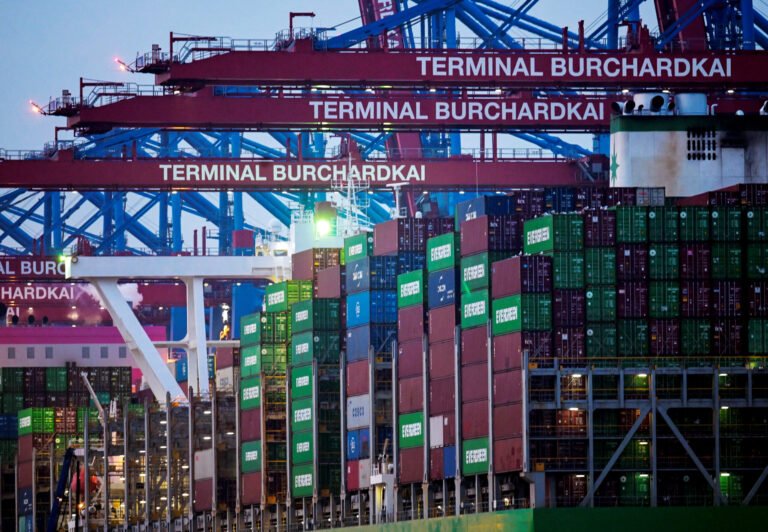Port Congestion and Trade Wars: Maritime Disruptions on the Rise
By Brendan Murray
May 25, 2025 (Bloomberg) — Port congestion is worsening at key gateways in northern Europe and other hubs, according to a new report which suggests trade wars could spread maritime disruptions to Asia and the US and push up shipping rates.
Waiting times for berth space jumped 77% in Bremerhaven, Germany, between late March and mid-May, according to the report Friday from Drewry, a maritime consultancy in London. The delays rose 37% in Antwerp and 49% in Hamburg over the same stretch, with Rotterdam and the UK’s Felixstowe also showing longer waits.
Labor shortages and low water levels on the Rhine River are the main culprits, hindering barge traffic to and from inland locations. Compounding the constraints is US President Donald Trump’s temporary rollback on 145% tariffs on Chinese imports, which has pulled forward shipping demand between the world’s largest economies.
“Port delays are stretching transit times, disrupting inventory planning and pushing shippers to carry extra stock,” Drewry said. “Adding to the pressure, the transpacific eastbound trade is showing signs of an early peak season, fueled by a 90-day pause in US–China tariffs, set to expire on Aug. 14.”
Similar patterns are emerging in Shenzhen, China, as well as Los Angeles and New York, “where the number of container ships awaiting berth has been increasing since” late-April, it said.
Rolf Habben Jansen, chief executive officer of Hamburg-based Hapag-Lloyd AG, said on a webinar last week that, although he’s seen recent signs of improvement at European ports, he expects it will take “another six to eight weeks before we have that under control.”
Still, Torsten Slok, Apollo Management’s chief economist, pointed out in a note on Sunday that the US-China tariff truce reached almost two weeks ago hasn’t yet unleashed a surge in ships across the Pacific.
EU-US Dispute
US tariffs – combined with sudden threats and truces – make it difficult for importers and exporters to calibrate their orders, causing unseasonal swings in demand. For shipping lines, those translate into delays and higher costs requiring freight rate hikes.
The latest blow to visibility came Friday when Trump threatened to hit the European Union with a 50% tariff on June 1, a move that could roil transatlantic trade.
“The additional policy uncertainty will be a deadweight cost to global activity by adding risks to decisions on expenditures,” Oxford Economics said in a research note on Saturday. Germany, Ireland, Italy, Belgium, and the Netherlands are the most vulnerable given their ratios of US exports to GDP, it said.
Bloomberg Economics said in a research note Friday that “additional tariffs of 50% would likely reduce EU exports to the US for all products facing reciprocal duties to near zero — cutting total EU exports to the US by more than half.”
Mounting uncertainty about whether Trump would follow through on such a big trade threat or postpone it like he did with China is adding to shipping pressures.
Carriers including MSC Mediterranean Shipping Co., the world’s largest container line, had already announced general rate increases and peak season surcharges, starting in June, for cargo from Asia.
In the weeks ahead, those are likely to boost spot rates for seaborne freight, the cost of which is still underpinned by geopolitical turmoil.
Cargo ships are still largely avoiding the Red Sea, where Yemen-based Houthis started attacking vessels in late 2023, and sailing around southern Africa to ferry goods on routes that connect Asia, Europe, and the US.
Avoiding ‘Massive Congestion’
On the webinar, Habben Jansen said it’s still not safe to traverse the Red Sea and indicated that any eventual restoration of regular journeys through the Suez Canal would have to be gradual, perhaps taking several months, to avoid flooding ports with vessel traffic.
“If we would from one day to another shift those ships back through Suez, we would create massive congestion in many of the ports,” Habben Jansen said. “So our approach would be that if we can do it, that we do it over a longer period of time so that the ports do not collapse, because that’s in nobody’s interest.”
© 2025 Bloomberg L.P.
Subscribe for Daily Maritime Insights
Sign up for gCaptain’s newsletter and never miss an update
— trusted by our 109,037 members

